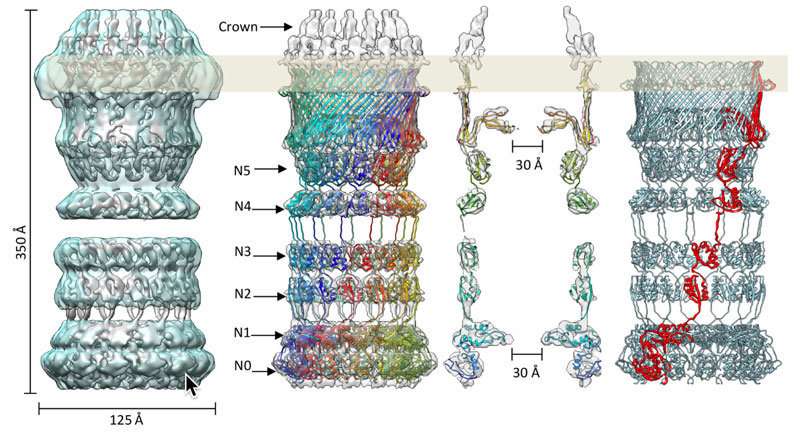Secretin protein with a crown

Bacteria are consummate survivalists. They are aided in this by their ability to assimilate DNA from their surroundings, which allows them to constantly acquire new characteristics. Researchers at the Max Planck Institute of Biophysics and Goethe University in Frankfurt have now gained new insights into exactly how bacteria import DNA.
The uptake of foreign genetic material from the environment is common trick used by bacteria to ensure their survival. For example, bacteria can become resistant to substances that would otherwise kill them. In this way, resistance is passed on from cell to cell. It has long been a mystery how a bacterial cell is able to import a molecule as complex as DNA. The Frankfurt research team has now achieved a breakthrough in answering that question.
"We have gained the first insights into part of a multi-protein DNA-binding machine. The machine pulls DNA through the outer cell layers, separates it into two single strands and assimilates one of them," Beate Averhoff explains. Working with a cryo-electron microscope with a resolution of seven angstroms, she has elucidated the three-dimensional structure of this machine, known as a secretin complex, in collaboration with research groups headed by Werner Kühlbrandt and Gerhard Hummer.
They discovered that the complex protrudes from the cell wall like a gun and bears a newly discovered "crown". Genetic studies have shown that the crown is not formed by the secretin protein itself. However, mutations in the gun-like structure cause the crown to disintegrate, so that the bacterial cell is no longer able to absorb DNA. "In the crown we may have discovered a crucial switch for the recognition and binding of DNA," says Edoardo D'Imprima of the Department of Structural Biology at the Max Planck Institute in Frankfurt.
The researchers now want to identify the protein that makes up the crown. "Our work is helping to improve our basic understanding of DNA transfer. But, of course, we also want to identify target structures that could inhibit DNA transfer and, for example, stem the spread of antibiotic resistance," D'Imprima says.
More information: Edoardo D'Imprima et al. Cryo-EM structure of the bifunctional secretin complex of Thermus thermophilus, eLife (2017). DOI: 10.7554/eLife.30483
Journal information: eLife
Provided by Max Planck Society


















